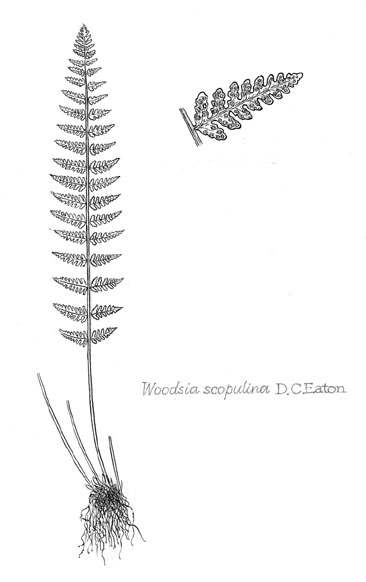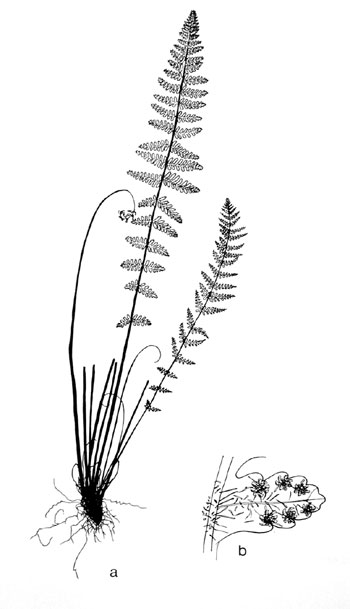|
Hardy Fern Home W. scopulina resources
All Ferns � Woodsiaceae �� Woodsia
�Other Genera
|
| Woodsia scopulina | ||
Mountain cliff fern | ||
|
Etymology
Scopulina is from the Greek, skopelos meaning peak, headland, or promontory.
Description
Rhizome: erect, scales brown, uniform and others with a dark central stripe.
Frond: 30 cm high by 5 cm wide, deciduous, monomorphic, blade/stipe ratio: 2:1. Stipe: shiny, chestnut-brown, persistent bases of unequal lengths, scales tan, vascular bundles: 2, round or oblong. Blade: 2-pinnate, but showing a great deal of variation, from not quite 2-pinnate to distinctly more, rhombic, tapering to both ends, truncated at base, herbaceous, gray-green, glands and sparsely hairy on both surfaces, rachis, costa with glandular hairs and scattered, white, jointed, hair-like scales. Pinnae: 10 to 15 pair, lowest distinctly reduced, sessile or nearly so, pairs further apart the closer to the base; costae grooved above, grooves continuous from rachis to costae; margins dentate or lobed; veins free, simple or forked, ending before the margin. Sori: round, near the margin, indusium: strap-like lobes encircling sorus, fraying at the tips, marginal hairs, basal, surrounding, sporangia: brown then black. Culture
Habitat: rock crevices, talus, ledges.
Distribution: western North America, scattered disjunct stations elsewhere in central, eastern N. A..
Hardy to -25�C, USDA Zone 5.
Distinctive Characteristics
Look at the synonyms to see how the experts get confused. The unjointed
stipe and the 2-pinnate division separates this from all but Ww. obtusa and oregona.
The glossy chestnut-brown stipe and rachis here is diagnostic as is the
white, jointed hair or hair-like scales on the lower surface of the
axes and blade.
Synonyms
Woodsia obtusa (Sprengel) Torrey var. lyallii Hooker Woodsia oregana D. C. Eaton var. lyallii (Hooker) Boivin |
|
|
Notes
Subtaxa Three subspecies are differentiated on the basis of characters not likely visible to the unaided eye. – Tom
Subtaxa Three subspecies are differentiated on the basis of characters not likely visible to the unaided eye. – Tom

Woodsia scopulina. Here the varied old stipe base lengths are evident in contrast to the other illustration. �Illustration by Edgar Paulton, from How to Know the Ferns and Fern Allies, John T. Mickel, � 1979 Wm. C. Brown Co. |
